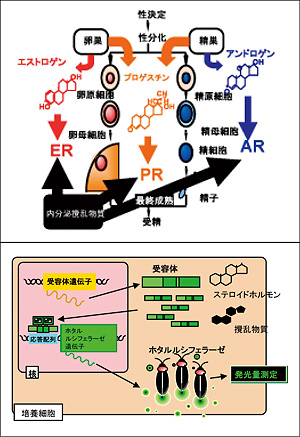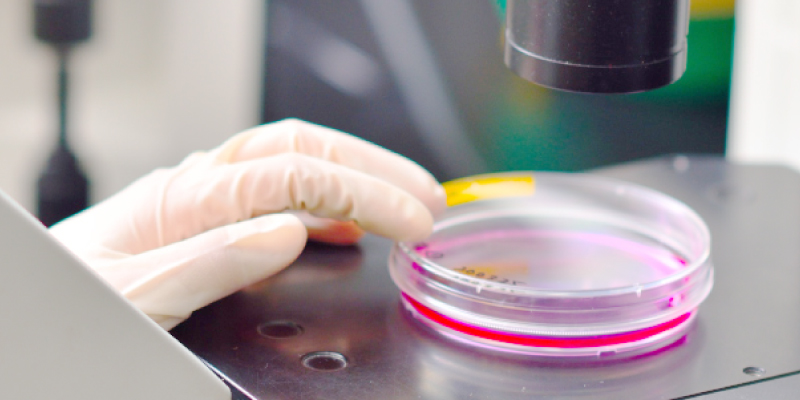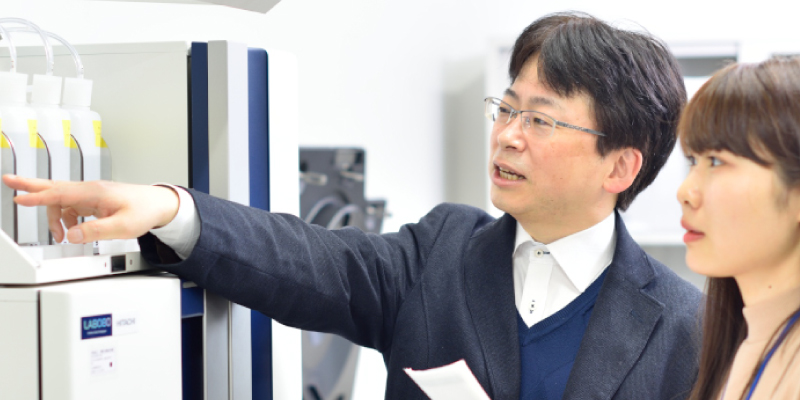フロンティアバイオサイエンス学科
 池内 俊貴(いけうち・としたか)
池内 俊貴(いけうち・としたか)
Toshitaka Ikeuchi
専門分野/環境分子応答学、生殖生理学、内分泌学
研究キーワード/環境ホルモン、組み換え細胞による測定
職位:准教授
学位:博士(水産学)(北海道大学)
- 北海道大学大学院水産学研究科博士後期課程修了
- 日本学術振興会特別研究員を経て本学へ
研究テーマ
魚類ステロイド受容体の分子機構
環境問題の一つ、内分泌撹乱について、その影響を受けやすい魚類を選び、その作用機構を分子レベルで研究している。特に、生殖に対する影響に焦点を当てた研究を行っている。内分泌系による生殖の調節機構は不明な点が多く残されており、基礎的な研究も行っている。
生殖を調節する内分泌系のうち、攪乱のターゲットとして性ステロイドホルモン系が考えられる。性ステロイドホルモンは、女性ホルモンとされるエストロゲンとプロゲスチン、男性ホルモンであるアンドロゲンの大きく3つに分類される(A)。エストロゲンとアンドロゲンは生殖腺だけでなく様々な組織にそれぞれの性に特異的な形質の発現を誘導するのが主な働きであると考えられている。プロゲスチンは哺乳類では妊娠の維持に関わるが、魚類では両性ともに最終成熟を調節するホルモンである。

これらの性ステロイドホルモンは核内受容体を介して作用する。攪乱の作用点としてこの受容体が考えられる(A)ため、受容体を利用した環境中に存在する攪乱物質の統括的な検出・測定系を構築した。これは、3種類の性ステロイド受容体遺伝子をそれぞれ組み込みレポータージーンアッセイが行える培養細胞である(B)。この細胞系を用いて環境水や食品、医薬品などの内分泌攪乱活性を調べる研究を滋賀県や企業と共同で進めている。
| 研究の応用領域 | 産官学連携で求めるパートナー |
|---|---|
| 攪乱物質による環境汚染の防止 | 水質調査関連の公的機関・企業 野外生物への影響を危惧する化学・製薬・食品企業 |
Topics of research
My interests are in the fundamental regulatory mechanisms by steroid hormones in teleost f ishes. A major focus of my current research is on the disruption of the steroid signalings. Many environmental contaminants, termed environmental endocrine disrupters (EEDs), have deleterious, sub-lethal ef f ects on vertebrate animals. Development, reproduction and growth are often impaired, and in many cases, this has been associated with the disruption of the endocrine systems controlling these processes, and linked to the steroid hormone-like actions of EEDs. Many EEDs bind to nuclear steroid hormone receptors, proteins that modulate the transcription of target genes following hormone binding. These EEDs may either activate nuclear receptors and hence gene transcription, or may block the binding of the naturally occurring ligand. Examples of ef f ects of EEDs (e.g., alkylphenolic chemicals, plasticizers, phthalates, pesticides and herbicides) on f ish include induction of vitellogenin, major yolk protein, synthesis by liver of male f ish, male to female sex reversal, and depression of hormones. I am pursuing two lines of research.
1. First,collaborating with Hiyoshi Corpotartion, a total environmental service company, and Industrial Research Center of Shiga prefecture, Lake Biwa Environmental Research Institute, we are developing the reporter-gene assays for quantif ication of EEDs. In teleost f ishes, the sensitivities to EEDs for sex steroids and corticosteroids are much dif f erent from those in mammalian species, because the former species have extra subtype in each receptor for glucocorticoid and sex hormone, such as estrogen, androgen and progestin. Because such EEDs are mainly concentrated into surface water, teleosts are most endangered. Therefore, reporter-gene assays for EEDs using f ish receptor genes were developed and tested for detection and estimation of aquatic pollution. Six kinds of cell lines were obtained about estrogen receptorαandβ, androgen receptor αandβ, progestin receptor αandβ, respectively. Because of high sensitivity of the order of 1 nM to corresponding hormones in all assays,they are a good system for rapid, sensitive and reproducible screening of various endocrine disruptors for each steroid signaling system. We name this system 'Biological inspection for Water Analysis' (abbreviate to BIWA). About glucocorticoid receptors, we are also developing reporter-gene assay systems.
2. Second, I screen the molecular marker at the endocrine disruption. As the aquatic environment represents the ultimate sink for most anthropogenic contaminants, f ish populations are directly exposed to a wide variety of EDCs, originating from industrial, agricultural or municipal ef f luents. There is now unequivocal evidence showing that EDCs can have long-term ef f ects on reproduction and subsequent population development in natural f ish populations. However, investigations based on the evaluation of reproductive endpoints are costly, time-consuming and laborious. This has generally resulted in these endpoints not being routinely integrated into most chemical safety assessments. However, since endocrine disruption can be clearly linked to molecular interactions, expression of appropriate biomarkers could be used as predictors for reproductive or other ef f ects. Although vitellogenin, a major yolk protein, has been actually used as biomarker estrogen disruption, no useful biomarkers for other steroid disruptions, I am now screening those biomarkers.
主な業績論文等
- K. Sakai, H. Fukushima, Y. Yamamoto, T. Ikeuchi (2017) A fourth subtype of retinoic acid receptor-related orphan receptors is activated by oxidized all-trans retinoic acid in medaka (Oryzias latipes) Zoological Lett. 3:11
- M. Yoshiki , H. Takahashi , M. Yoshida , Y. Ogino , T. Ikeuchi , T. Nakamachi , N. Konno , K. Matsuda , H. Sakamoto, T. Sakamoto (2016) Principal function of mineralocorticoid signaling suggested by constitutive knockout of the mineralocorticoid receptor in medaka fish. Sci Rep. 6:37991
- H. Takahashi, T. Sato, T. Ikeuchi, K. Saito, M. Sakaizumi, T. Sakamoto (2016) High levels of plasma cortisol and impaired hypoosmoregulation in a mutant medaka deficient in P450c16I as functional materials Mol Cell Endocrinol. 430:25-32






